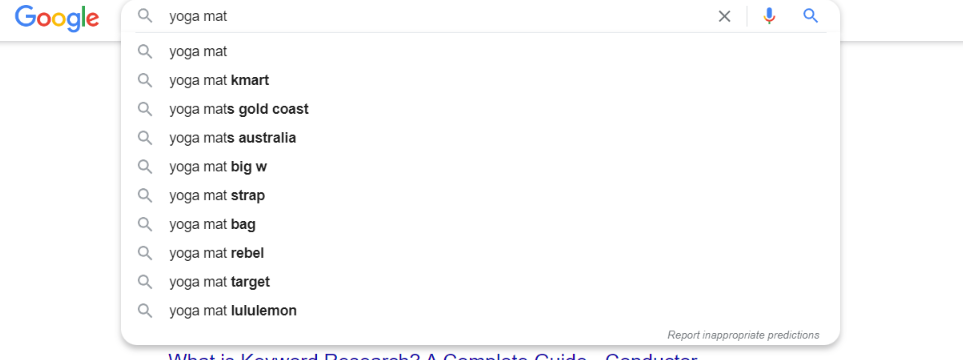How to Do Keyword Research for SEO
I hear a lot of my clients and fellow small biz owners say that SEO overwhelms them. They don’t know where to start. They don’t know what to do. It’s all too much. So, they either fork it over to specialist a to do it for them, or they don’t do it at all.
But not doing SEO for your business? It's such a wasted opportunity!
SEO is the most sustainable source of traffic for your website. When you post content on a social media channel, it's only visible for a short amount of time before it gets lost in the feed. But, your content can remain visible for years on a search engine.
Plus, when someone finds you through Google or another search engine? There's a much better chance that they were searching for exactly what you have to offer, and they've come to your site as a pre-qualified lead. And those leads? They're much easier to convert into a paying client or customer.
It's important to include SEO in your marketing strategy. Whether you do it yourself or outsource it to an expert. If you're planning on taking the DIY path, then this post is for you. It's a super handy, action-focused, jargon-free (or at least explained) how-to guide to teach you how to do your own keyword research.
Ready to begin?
What is Keyword Research?
Keyword research is the process of discovering what search terms people are typing into search engines. Aka, what they’re Googling when they’re looking for products, services, or information. Your SEO strategy can’t be built on guesses when it comes to your search terms. You need to go through the process of finding and analysing the keywords that your audience is using to find you, or businesses like you.
Why is Keyword Research Important?
Keyword research isn’t rocket science, but it is the foundation of SEO, so it’s still kinda important.
Here’s why. If you publish a page on a topic that no one is searching for, that page won’t receive any traffic from search engines. No matter how good the content might be. In order for people to find your content through search, then they have to actually be searching for it. And that’s where keyword research comes in. Conducting keyword research before you create your content will assure you that there is a demand for that content. It’s a win-win-win. You aren’t wasting your time creating content no one is looking for. Your audience is able to find valuable content on what they are searching for. And your website will start to enjoy a consistent stream of targeted visitors.
Choose a Keyword Research Tool
Keyword research is not a guessing game. There are loads of free (and paid-for) tools that you can use to add meaningful data to the research phase of this process. A few of my favourite tools (both free and paid) you can use include:
How to Find Keywords
#1. Start with a Braindump
For your main website pages (homepage, about, services etc), you need to find keywords that are related to your industry, service, product or location. Then you want to assign one main keyword to each page. The key to keyword research is to put yourself in your customers’ shoes. What words or phrases might they use to find solutions to their problems? The solutions that you provide. A good place to start is with an old-fashioned brain dump. Write down any and all words and phrases that you can think of that relate to your industry and your products or services.
Let’s say you sell yoga mats from a little store in Byron Bay. Start by making a list of obvious keywords your target audience might use to find you on Google.
yoga mat
exercise mat
fitness mat
yoga equipment
non-slip yoga mat
yoga mats Byron Bay
Choose one of your keywords and enter it into SERanking, or the keyword tool of your choice. You’ll see heaps of data related to your keyword, but there are two things you should pay attention to the most: difficulty and search volume.
The higher the search volume (aka, people searching for your keyword), and the lower the difficulty (aka, competition with other websites), the better! In the example above, you can see that “yoga mat” has a huge search volume, but it’s also rated as “challenging” on the difficulty score. Not ideal! But you can see that tweaking this slightly to be more specific - “yoga mat Byron Bay” - now shows a much lower search volume, but also a much easier difficulty ranking. The search volume is much lower, but as it is so location-specific, the audience is much more qualified. Plus, you will have a higher chance of ranking for it because it has a low SEO difficulty.
If you must choose between keywords with high volume and keywords with low difficulty, go with the keywords that are easier to tank for. It’s better to be at the top of the search results for a keyword that gets 70 searches per month, than on page 5 for a keyword that gets 22,000 searches a month. Because on page 5? It’s unlikely you’ll ever get seen anyway.
#2. Add Related Terms
If you’re using a tool like SERanking for your keyword research, you’ll see that with each word you search for, you’ll also be presented with a ton of similar keywords, along with their search volume and difficulty level. As you research all of your initial keywords (as per point #1), jot down any related keywords that have low difficulty and decent traffic volume. In the example below, you can see some of the suggestions straight away, but then you can also view a more detailed report to get this data on each keyword included. Jot down any related keywords that have low difficulty and a decent traffic volume.
Repeat steps 1 and 2 for all of your original keywords.
I do want to make a quick note here about search intent.
It’s important to include keywords that match the intent of your audience. This is something that a computer-based research tool can’t do for you. You need to rely on your own insights and expertise here. For example, you can see above that “byron bay yoga retreat” comes up as a related keyword. The intent behind this search is more likely to be someone searching for a yoga retreat in the area, as opposed to buying a yoga mat. They’re likely to not be your target audience, so even if they do have low search difficulty and decent search volume, you don’t want to add keywords to your list that don’t match user intent for your products or services.
#3. Know Your Competitors’ Keywords
Another great way to find keywords is to know what your competitors are ranking for. If you’re unsure of who your competitors are, a quick Google search can help. Using our yoga mats example, you can type “yoga mat Byron Bay” into a search engine and see which businesses show on the first page of the search results. You can then take their URL and enter it into an SEO tool to see the keywords they rank for, along with search volume and difficulty ranking for each keyword. Do this for all of the top competitors that you found for your business, and add any new keywords to your list.
#4. Get Creative
There are a few other things you can do to get a bit more creative with your keyword research and ensure you’re not missing anything important.
Plug your keyword into Google and see what related search terms come up
Use Answer the Public to discover topics that people are asking about
Look at the questions your audience is asking you directly, or what they may be asking in social groups
Use a tool like Google Trends to find what topics are trending right now
Use Google Analytics and Google Search Console to see what search terms are already sending traffic to your website
How to Analyse Your Keywords
You should now have a pretty decent list of keywords to use. In reality, probably too many to focus on. Now it’s time to narrow your focus and choose the keywords that are best suited to your short- and long-term strategies and goals. Here are a few tips to help you do that:
Look at the Data
You’ve got all of this data on your keyword list. Now it’s time to put it to good use. Go through your list of keywords and flag any that have way too little (or way too much) search volume. Next, flag any that are on the ridiculously high difficulty level. You want to aim for a healthy mix of decent search volume, but low ranking difficulty.
Create a Priority List
Now highlight 10 to 15 keywords that match these criteria:
decent search volume
low ranking difficulty
search intent related to your products or services
support your short-term goals & make sense to your business
You now have your priority list.
*Don’t get rid of the rest of the keywords. These will help support your long-term goals, and you can come back to those later once your website has gained some SEO traction, which will make it easier to start ranking for those more difficult, higher-volume search terms.
Bonus Tips
Blogging is a great way to boost your SEO efforts, but keyword research for blogs is a little different to what you do for your main web pages. Instead of targeting your core industry terms (that you’ve shortlisted above), you want to target keywords that are related to the subject of your blog post.
If you already have a blog idea, for example “what is the best type of yoga mat” - you want to find keywords that are related to this topic, keeping search intent in mind. Using your keyword tool, you can start to come up with a list of potential keywords. For example:
what is the best thickness for a yoga mat
what is the best yoga mat for beginners
different types of yoga mats
Then follow the same process as above, selecting the keywords that have decent search volume and low difficulty.
If you don’t have a topic you want to write about yet, tools like Answer the Public, BuzzSumo and Google Trends can help fire up those brainstorming gears. Then just repeat the process above for your keyword focus.
To DIY or To Outsource
As I said at the beginning of this post, you absolutely should be doing SEO as part of your marketing strategy. It’s just a question as to whether you do it yourself, or you outsource it. Hopefully, this guide has shown you that it doesn’t really have to be that difficult. With the right tool, keyword research doesn’t have to involve a lot of guesswork. It can be a simple process that results in a data-driven strategy. No guesses. No uncertainty. No fluff.
If you’re keen to try your hand at doing your own SEO, here is a freebie for you to use. This is my go-to template when I am doing keyword research for my clients.








